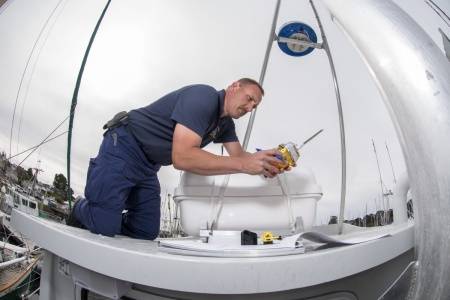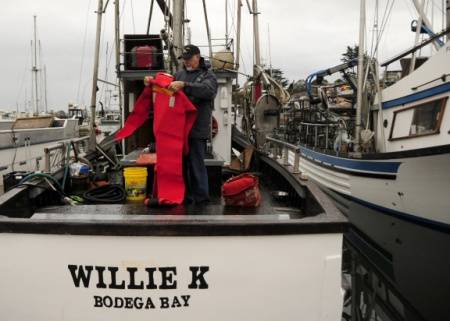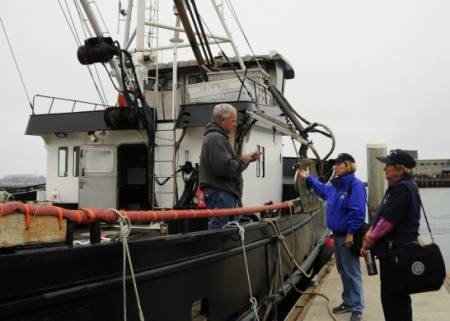USCG Shines Safety Spotlight on Crab Fishing
Posted by Eric Haun
October 27, 2015

Coast Guard marine inspector Lt. Cmdr. David Cripe goes trough required vessel safety equipment on a newly registered fishing vessel in Santa Cruz, Calif., September 29, 2015. "These prescreening inspections are more relaxed. We want them to pass, so we just go through and point out what they need to get or fix," said Cripe. (U.S. Coast Guard photo by Adam Stanton)

Ronald Kram, a Coast Guard Auxiliarist, inspects an immersion suit aboard the Willie K, a crab vessel moored in Spud Point Marina in Bodega Bay, November 8, 2012. (U.S. Coast Guard photo by Pamela J. Boehland)

Coast Guard Auxiliarists walk the docks of Hyde Street Pier in San Francisco offering a free safety examination to a crab fisherman prior to the start of crab season, November 2012. (U.S. Coast Guard photo by Pamela J. Boehland)
One of the most dangerous jobs in America is commercial fishing, and Dungeness crab fishing is the most deadly of all West Coast commercial fisheries.
Aiming to help reduce the number of deaths, injuries and accidents, U.S. Coast Guard fishing vessel safety experts will visit Northern California fishing ports in early November ahead of California's commercial Dungeness crab season.
The season is scheduled to begin at midnight November 14 for the central coast (Avila-Morro Bay to the mouth of the Russian River) and December 1 for the northern coast (Russian River to the Oregon border). Coast Guard personnel will be on the docks in ports from Monterey to Crescent City November 3-5 to help identify and mitigate safety hazards in the crab fleet.
The fishing vessel safety experts will walk the docks and inform commercial fishers of the required lifesaving equipment for their vessels via dockside exams and safety spot checks. Under federal regulations, as of October 15, 2015, all commercial fishing vessels operating outside three nautical miles from the coast are required to have a mandatory dockside safety examination. Dockside safety exams are valid for up to five years and have been instrumental in reducing the number of casualties in the fleet. Vessels found underway with serious safety discrepancies, such as overloading, missing primary life-saving equipment or non-functioning emergency position-indicating radio beacons, can be restricted from operating until the discrepancies are corrected.
Preseason safety exams are part of the Coast Guard's Commercial Fishing Vessel Safety Program that was implemented in 1991 and is designed to help commercial fishers identify and eliminate potential safety hazards.






